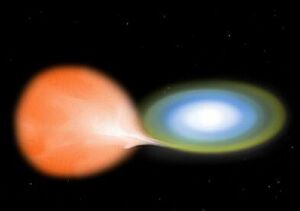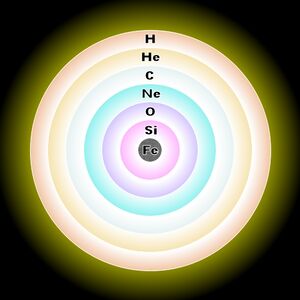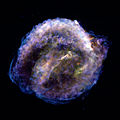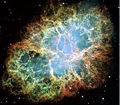10th Week: Supernovae and Nucleosynthesis B
Supernova
The final stage of the life of stars can be very different and depends strongly on the mass of the individual stars. Some stars will just consume all their nuclear fuel and die quietly, but there are special cases in which the star ends its life with a violent explosion that can last for days and its luminosity can be compared to the one of a galaxy. This process is called supernova.There are several different classes of supernovae with different classifications due to progentors and mechanisms.
Type I

Type Ia supernovae are classified as supernova that do not have any hydrogen lines in their spectra. It is interesting to note that since hydrogen is the most abundant element in the universe that it is strange that we do not see hydrogen in these lines. Not having these lines indicates that the stars have had their hydrogen envelopes stripped.
Type Ia
Type 1a supernova, also called thermonuclear supernova are classified specifically in that they display strong Si II line at 615 nm.These supernovae begin with a White Dwarf (WD) star with mass close to 1 solar mass. Very special conditions need to be satisfied in order for the WD to become a supernova. This is because the WD has to accrete matter, for example, if the WD is part of a binary system, the other star will be the source of matter for the WD (see Figure 2). Other methods for the accretion of matter have been proposed but these methods are very rare. One such method is the collision of two white dwarf stars. Such a collision will meet all of the following criteria but is too rare an event to satisfy the number of type Ia explosions seen. Once the WD has reached Chandrasekhar limit (1.44 solar masses) the following reactions start taking place in the carbon-oxygen core of the WD
After this the following decays take place
All these reactions occur in a very short time, of the order of seconds. Thus an enormous amount of nuclear energy is released violently in the form of an explosion. This explosion also is the same for every star. This makes it a useful tool for checking stellar distances.
Type II

Type II supernovae contain strong hydrogen lines. A type II supernova can occur if the mass of the star exceeds (roughly) 9 solar masses. Unlike type Ia, type II supernovae do not require accretion of matter from an external source. The progenitor of a type II supernova is a massive star that first consumes the hydrogen in its core by nuclear fusion generating mostly helium and leaving a hydrogen shell. When the pressure and temperature are high enough helium can start burning in the core generating several nuclides like carbon and oxygen. This process continues creating an onion-like structure of the progenitor (see Figure 1) with 56Fe in the core. At this point no nuclear fusion process can generate more energy, thus there is not enough outward pressure that can keep the star from collapsing by its own weight.
Type Ib
Type Ib supernovae are based on the existence of strong hydrogen helium lines. This occurs when the explosion does not fully explode and some helium survives the detonation.
Type Ic
Type Ic supernovae are based on no helium, hydrogen, or silicon lines being present. This leaves strong lines of carbon and oxygen and therefore these stars have not detonated fully either.
Core collapse
Once the star starts collapsing the high temperature in the core enables photo-disintegration which can take Fe in several steps all the way back to He. In the way back to He, there is a great deal of neutron generated and some more neutrons and neutrinos appear from the electron capture process, also enabled by the high temperature and pressure. A new neutron core is generated in a very short time that has an initial temperature of about 100 GK. The core gets rid of a lot of its energy by releasing neutrinos. Approximately 10% of the star's rest mass is converted into a ten-second burst of neutrinos; the main output of the event.
When the neutron core reaches typically 30 km diameter, and the density will be comparable to that of an atomic nucleus. Further collapse is abruptly stopped by strong force interactions and by degeneracy pressure of neutrons.
Light Curve
The explosion provides much of the early part of the light curve for these supernovae. However, these supernovae have tails which extend the lifetime of the explosion. These tails are produced by decaying atoms like cobalt decay and titanium decay.These two joined with all of the other decays produce the light curve tails which can last years after the explosion.
Nucleosynthesis
Inside a supernova nuclides can be produced, mainly due to the explosive oxygen burning and silicon burning. These fusion processes can generate the elements Na (sodium), Si (silicon), P (phosphorus), S (sulfur), Cl (chlorine), Ar (argon), K (potassium), Ca (calcium), Sc (scandium), Ti (titanium), V (vanadium), Cr (chromium), Mn (manganese), Fe (iron), Co (cobalt) and Ni, (nickel) are created.






